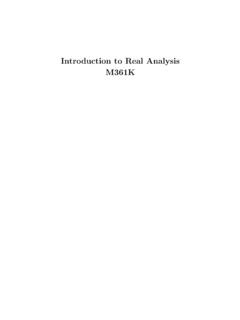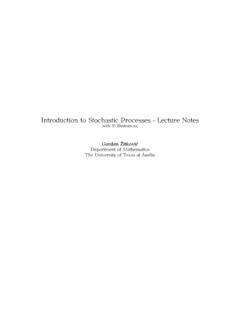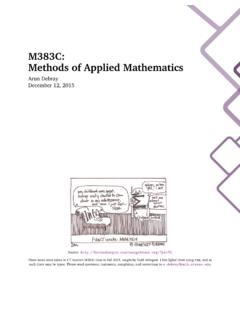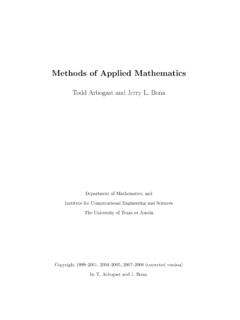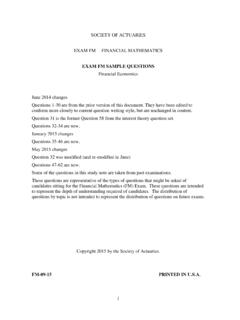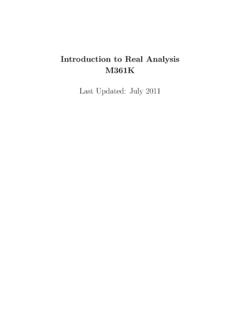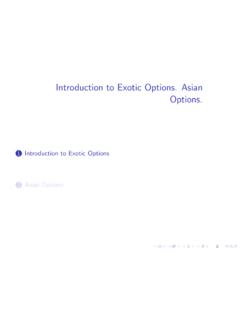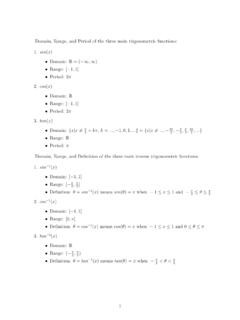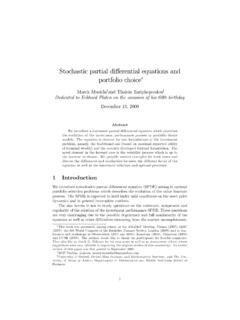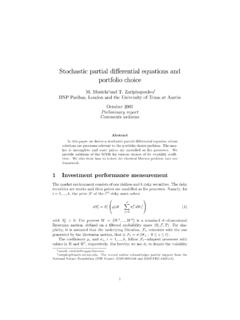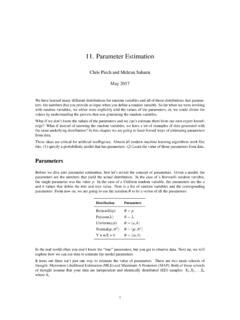Transcription of Uniform Integrability - University of Texas at Austin
1 Lecture 12: Uniform Integrability 1 of 12. Course: Theory of Probability II. Term: Fall 2015. Instructor: Gordan Zitkovic Lecture 12. Uniform Integrability Uniform Integrability is a compactness-type concept for families of random variables, not unlike that of tightness. Definition ( Uniform Integrability ). A non-empty family X L0. of random variables is said to be uniformly integrable (UI) if ! lim sup E[| X | 1{| X | K } ] = 0. K X X. Remark It follows from the dominated convergence theorem (prove it!) that lim E[| X | 1{| X | K } ] = 0 if and only if X L1 , K . , that for integrable random variables, far tails contribute little to the expectation. Uniformly integrable families are simply those for which the size of this contribution can be controlled uniformly over all elements. We start with a characterization and a few basic properties of Uniform - integrable families: Proposition (UI = L1 -bounded + uniformly absolutely continu- ous). A family X L0 of random variables is uniformly integrable if and only if 1.
2 There exists C 0 such that E[| X |] C, for all X X , and 2. for each > 0 there exists > 0 such that for any A F , we have P[ A] sup E[| X | 1 A ] . X X. Proof. UI 1., 2. Assume X is UI and choose K > 0 such that sup E[| X | 1{| X |>K } ] 1. X X. Since E[| X |] = E[| X | 1{| X | K } ] + E[| X | 1{| X |>K } ] K + E[| X | 1{| X |>K } ], Last Updated: January 24, 2015. Lecture 12: Uniform Integrability 2 of 12. for any X, we have supX X E[| X |] K + 1, and 1. follows. For 2., we take > 0 and use the Uniform Integrability of X to find a constant K > 0 such that supX X E[| X | 1{| X |>K } ] < /2. For = 2K.. and A F , the condition P[ A] implies that E[| X | 1 A ] = E[| X | 1 A 1{| X | K } ] + E[| X | 1 A 1{| X |>K } ]. KP[ A] + E[| X | 1{|X |>K} ] . 1., 2. UI. Let C > 0 be the bound from 1., pick > 0 and let > 0 be such that 2. holds. For K = C , Markov's inequality gives P[| X | K ] K E[| X |]. 1. , for all X X . Therefore, by 2., E[| X | 1{| X | K } ] for all X X.
3 Remark Boundedness in L1 is not enough for Uniform integra- bility. For a counterexample, take ( , F , P) = ([0, 1], B([0, 1]), ), and define . n, 1 , n Xn ( ) =. 0, otherwise. Then E[ Xn ] = n n1 = 1, but, for K > 0, E[| Xn | 1{| Xn | K } ] = 1, for all n K, so { Xn }n N is not UI. Problem Let X and Y be two uniformly-integrable families (on the same probability space). Show that the following families are also uniformly integrable: 1. { Z L0 : | Z | | X | for some X X }. 2. { X + Y : X X , Y Y }. Another useful characterization of Uniform Integrability uses a class of functions which converge to infinity faster than any linear function: Definition (Test function of UI). A Borel function : [0, ) . [0, ) is called a test function of Uniform Integrability if ( x ). lim x = . x . Proposition (Characterization of UI via test functions). A nonempty family X L0 is uniformly integrable if and only if there exists a test func- tion of Uniform Integrability such that sup E[ (| X |)] <.]]
4 ( ). X X. Moreover, if it exists, the function can be chosen in the class of non- decreasing convex functions. Last Updated: January 24, 2015. Lecture 12: Uniform Integrability 3 of 12. The proof of necessity rests on a simple fact from analysis: Lemma (Functions arbitrary close to Integrability ). Let f : [0, ) . [0, ) be a non-increasing function with f ( x ) 0, as x . Then, there exists a continuous function g : [0, ) (0, ) such that Z Z . g( x ) dx = + but f ( x ) g( x ) dx < . ( ). 0 0. Rx Moreover, g can be chosen so that the function x 7 x 0 g( ) d is convex. Proof. Let f be a strictly positive continuously differentiable with f ( x ) . f ( x ), for all x 0, with f ( x ) 0, as x . With such f and g = f 0 / f , we have Z . g( x ) dx = lim ln( f (0)) ln( f ( x )) = . 0 x . R R . On the other hand 0 f ( x ) g( x ) dx 0 f ( x ) g( x ) dx = limx f (0) .. f ( x ) = f (0) < . We leave it to the reader to argue that a (perhaps even larger) f can be constructed such that x 7 x ln f ( x ) is convex.]]]
5 Proof of Proposition Suppose, first, that ( ) holds for some test function of Uniform Integrability and that the value of the supremum is 0 M < . For n > 0, there exists Cn R such that ( x ) nMx, for x Cn . Therefore, M E[ (| X |)] E[ (| X |)1{| X | Cn } ] nME[| X | 1{| X | Cn } ], for all X X . Hence, supX X E[| X | 1{| X | Cn } ] n1 , and the Uniform Integrability of X follows. Conversely, if X is uniformly integrable the function f (K ) = sup E[| X | 1{| X | K } ], X X. satisfies the conditions of Lemma and a function g for which ( ) holds can be constructed. Consequently, the function ( x ) =. Rx x 0 g( ) d is a test-function of Uniform Integrability . On the other hand, for X X , we have Z . E[ (| X |)] = E[| X | 1{K | X |} g(K ) dK ]. 0. Z . = g(K )E[| X | 1{| X | K } ] dK. 0. Z . = g(K ) f (K ) dK < . 0. Last Updated: January 24, 2015. Lecture 12: Uniform Integrability 4 of 12. Corollary (L p -boundedness implies UI for p > 1). For p > 1, let X be a nonempty family of random variables bounded in L p , , such that supX X || X ||L p <.
6 Then X is uniformly integrable. Problem Let X be a nonempty uniformly-integrable family in L0 . Show that conv X is uniformly-integrable, where conv X is the smallest convex set in L0 which contains X , , conv X is the set of all random variables of the form X = 1 X1 + + n Xn , for n N, k 0, k = 1, .. , n, nk=1 k = 1 and X1 , .. , Xn X . Problem Let C be a non-empty family of sub- -algebras of F , Hint: Argue that it follows directly from and let X be a random variable in L1 . The family Proposition that E[ (| X |)] < for some test function of Uniform integrabil- ity. Then, show that the same can be X = {E[ X |F ] : F C}, used to prove that X is UI. is uniformly integrable. First properties of uniformly-integrable martingales When it is known that the martingale { Xn }n N is uniformly inte- grable, a lot can be said about its structure. We start with a definitive version of the dominated convergence theorem: Proposition (Improved dominated-convergence theorem).
7 Sup- pose that { Xn }n N is a sequence of random variables in L p , where p 1, which converges to X L0 in probability. Then, the following statements are equivalent: p 1. the sequence {| X |n }n N is uniformly integrable, Lp 2. Xn X, and 3. || Xn ||L p || X ||L p < . Proof. 1. 2.: Since there exists a subsequence { Xnk }k N such that Xnk X, Fatou's lemma implies that p p E[| X | p ] = E[lim inf Xnk ] lim inf E[ Xnk ] sup E[| X | p ] < , k k X X. where the last inequality follows from the fact that uniformly-integrable families are bounded in L1 . Now that we know that X L p , Uniform Integrability of {| Xn | p }n N. implies that the family {| Xn X | p }n N is UI (use Problem , 2.). P P. Since Xn X if and only if Xn X 0, we can assume without loss of generality that X = 0 , and, consequently, we need to show that Last Updated: January 24, 2015. Lecture 12: Uniform Integrability 5 of 12. E[| Xn | p ] 0. We fix an > 0, and start by the following estimate E[| Xn | p ] = E[| Xn | p 1{| Xn | p /2} ] + E[| Xn | p 1{| Xn | p > /2} ].
8 ( ). /2 + E[| Xn | p 1{|Xn | p > /2} ]. By Uniform Integrability there exists > 0 such that sup E[| Xn | p 1 A ] < /2 whenever P[ A] . n N. Convergence in probability now implies that there exists n0 N such that for n n0 , we have P[| Xn | p > /2] . It follows directly from ( ) that for n n0 , we have E[| Xn | p ] . 2. 3.: || Xn ||L p || X ||L p || Xn X ||L p 0. 3. 1.: For M 0, define the function M : [0, ) [0, ) by . x, . x [0, M 1]. M ( x) = 0, x [ M, ).. interpolated linearly, x ( M 1, M ).. For a given > 0, dominated convergence theorem guarantees the existence of a constant M > 0 (which we fix throughout) such that . E[| X | p ] E[ M (| X | p )] < . 2. Convergence in probability, together with continuity of M , implies that M ( Xn ) M ( X ) in probability, for all M, and it follows from boundedness of M and the bounded convergence theorem that E[ M (| Xn | p )] E[ M (| X | p )]. ( ). By the assumption 3. and ( ), there exists n0 N such that E[| Xn | p ] E[| X | p ] < /4 and E[ M (| X | p )] E[ M (| Xn | p )] < /4, for n n0.]]]
9 Therefore, for n n0 . E[| Xn | p 1{| Xn | p > M} ] E[| Xn | p ] E[ M (| Xn | p )]. /2 + E[| X | p ] E[ M (| X | p )] . Finally, to get Uniform Integrability of the entire sequence, we choose an even larger value of M to get E[| Xn | p 1{| Xn | p > M} ] for the re- maining n < n0 . Problem For Y L1+ , show that the family { X L0 : | X | . Y, } is uniformly integrable. Deduce the dominated convergence theorem from Proposition Last Updated: January 24, 2015. Lecture 12: Uniform Integrability 6 of 12. Since convergence in L p implies convergence in probability, we have: Corollary (L p -convergent UI, for p 1). Let { Xn }n N0 be an L p -convergent sequence, for p 1. Then family { Xn : n N0 } is UI. Since UI (sub)martingales are bounded in L1 , they converge by Theorem Proposition guarantees that, additionally, conver- gence holds in L1 : Corollary (UI (sub)martingales converge). Uniformly-integrable (sub)martingales converge , and in L1 . For martingales, Uniform Integrability implies much more: Proposition (UI martingales are L vy martingales).
10 Let { Xn }n N0. be a martingale. Then, the following are equivalent: 1. { Xn }n N0 is a L vy martingale, , it admits a representation of the form Xn = E[ X |Fn ], , for some X L1 (F ), 2. { Xn }n N0 is uniformly integrable. 3. { Xn }n N0 converges in L1 , In that case, convergence also holds , and the limit is given by E[ X |F ], where F = ( n N0 Fn ). Proof. 1. 2. The representation Xn = E[ X |Fn ], , and Problem imply that { Xn }n N0 is uniformly integrable. 2. 3. Corollary 3. 2. Corollary 2. 1. Corollary implies that there exists a random variable Y L1 (F ) such that Xn Y , and in L1 . For m N and A Fm , we have |E[ Xn 1 A Y1 A ]| E[| Xn Y |] 0, so E[ Xn 1 A ] E[Y1 A ]. Since E[ Xn 1 A ] = E[E[ X |Fn ]1 A ] = E[ X1 A ], for n m, we have E[Y1 A ] = E[ X1 A ], for all A n Fn . The family n Fn is a -system which generated the sigma algebra F = ( n Fn ), and the family of all A F such that E[Y1 A ] =. E[ X1 A ] is a -system. Therefore, by the Theorem, we have E[Y1 A ] = E[ X1 A ], for all A F.
